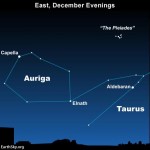
Tonight … notice that the stars are like wildflowers, in that each star radiates with a different color of the rainbow. Have you ever noticed their various hues? Let’s explore some of the stars that you’ll see in the meadow of night tonight.
In the northeastern sky at evening shines a bright star called Capella, the Little She Goat, in the constellation Auriga. Like brighter Sirius, which rises around 8 to 9 p.m. in the southeast, Capella often flickers madly when low in the sky. This effect has nothing to do with the stars themselves but rather is caused by Earth’s turbulent atmosphere.
The effect is particularly prominent with the stars Capella and Sirius because they are so bright.
Can you spot Capella? If so, notice that it’s a golden star. A star’s spectral type indicates its color. Capella is a G star, and, in that classification, it’s like our sun. Both our sun and Capella shine with a golden light.
Sirius, by the way – the sky’s brightest star, after the sun – is almost always described as a white star.
EarthSky astronomy kits are perfect for beginners. Order today from the EarthSky store

The constellation Auriga in the northeast sky at nightfall in December. The brightest star in this constellation is golden Capella. The bright red star just above the horizon is Aldebaran in the constellation Taurus. Image via AlltheSky.com
The stars’ true colors are apparent when they climb higher in the sky and above the turbulence of Earth’s atmosphere. If you have good eyesight and a dark, clear sky, you should be able to detect hints of color with the brighter stars. If you have difficulty discerning star colors with the unaided eye, try looking at these stars with binoculars.
Also contrast golden Capella with the reddish star Aldebaran and the stars of the misty Pleiades cluster higher up.
The light of a star reveals many things, but most directly the stars’ surface temperatures. The yellowish color of Capella indicates a mid-range surface temperature, much like our sun. The red of Aldebaran is typical of the lower surface temperature of an older star, whereas the blue of the Pleiades reveals their high surface temperature and young age.
The blue-white star Elnath, by the way, is officially part of Taurus, but it typically is considered part of Auriga as well.
There is a whole spectrum of stellar color sparkling in the sky tonight, from cool red stars to hot blue-white ones, and middle range yellow stars!

The H-R diagram, showing the colors of stars. Image via Wikipedia
Bottom line: Winter is the perfect season for noticing the colors of the stars. Never noticed them? Our sky chart can help guide your eye.
Never miss another full moon. Order your 2018 EarthSky lunar calendar today!
Donate: Your support means the world to us
from EarthSky https://ift.tt/2RvQLHj

Tonight … notice that the stars are like wildflowers, in that each star radiates with a different color of the rainbow. Have you ever noticed their various hues? Let’s explore some of the stars that you’ll see in the meadow of night tonight.
In the northeastern sky at evening shines a bright star called Capella, the Little She Goat, in the constellation Auriga. Like brighter Sirius, which rises around 8 to 9 p.m. in the southeast, Capella often flickers madly when low in the sky. This effect has nothing to do with the stars themselves but rather is caused by Earth’s turbulent atmosphere.
The effect is particularly prominent with the stars Capella and Sirius because they are so bright.
Can you spot Capella? If so, notice that it’s a golden star. A star’s spectral type indicates its color. Capella is a G star, and, in that classification, it’s like our sun. Both our sun and Capella shine with a golden light.
Sirius, by the way – the sky’s brightest star, after the sun – is almost always described as a white star.
EarthSky astronomy kits are perfect for beginners. Order today from the EarthSky store

The constellation Auriga in the northeast sky at nightfall in December. The brightest star in this constellation is golden Capella. The bright red star just above the horizon is Aldebaran in the constellation Taurus. Image via AlltheSky.com
The stars’ true colors are apparent when they climb higher in the sky and above the turbulence of Earth’s atmosphere. If you have good eyesight and a dark, clear sky, you should be able to detect hints of color with the brighter stars. If you have difficulty discerning star colors with the unaided eye, try looking at these stars with binoculars.
Also contrast golden Capella with the reddish star Aldebaran and the stars of the misty Pleiades cluster higher up.
The light of a star reveals many things, but most directly the stars’ surface temperatures. The yellowish color of Capella indicates a mid-range surface temperature, much like our sun. The red of Aldebaran is typical of the lower surface temperature of an older star, whereas the blue of the Pleiades reveals their high surface temperature and young age.
The blue-white star Elnath, by the way, is officially part of Taurus, but it typically is considered part of Auriga as well.
There is a whole spectrum of stellar color sparkling in the sky tonight, from cool red stars to hot blue-white ones, and middle range yellow stars!

The H-R diagram, showing the colors of stars. Image via Wikipedia
Bottom line: Winter is the perfect season for noticing the colors of the stars. Never noticed them? Our sky chart can help guide your eye.
Never miss another full moon. Order your 2018 EarthSky lunar calendar today!
Donate: Your support means the world to us
from EarthSky https://ift.tt/2RvQLHj

Aucun commentaire:
Enregistrer un commentaire